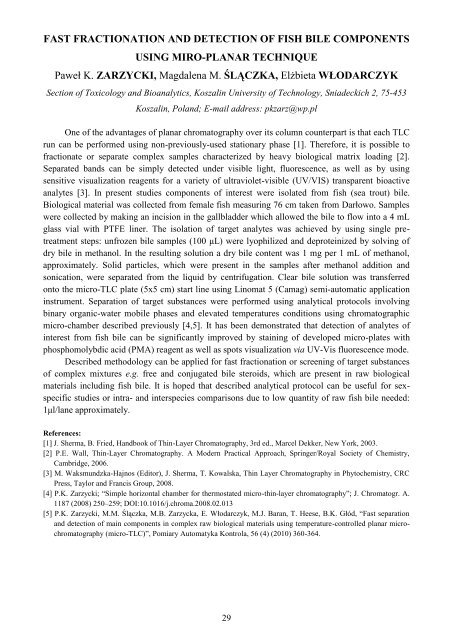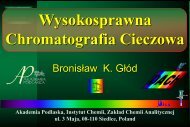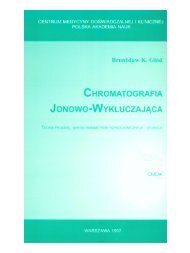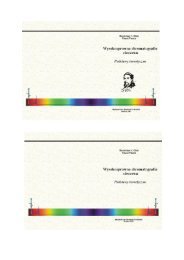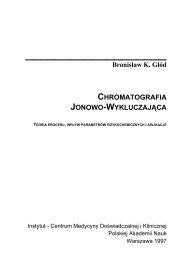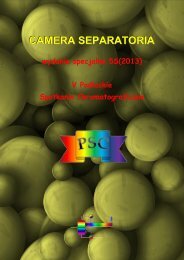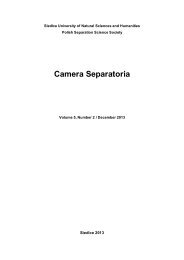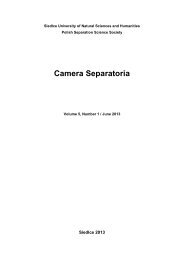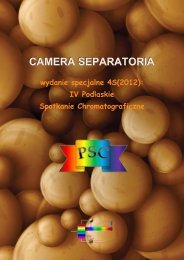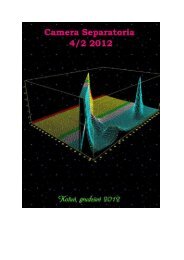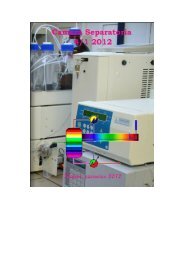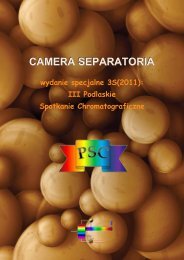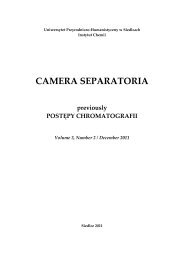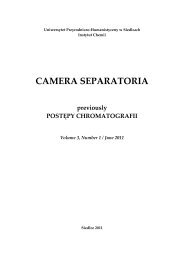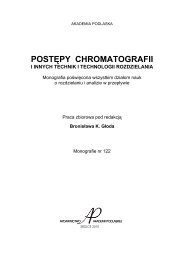CamSep 2 S
Create successful ePaper yourself
Turn your PDF publications into a flip-book with our unique Google optimized e-Paper software.
FAST FRACTIONATION AND DETECTION OF FISH BILE COMPONENTS<br />
USING MIRO-PLANAR TECHNIQUE<br />
Paweł K. ZARZYCKI, Magdalena M. ŚLĄCZKA, Elżbieta WŁODARCZYK<br />
Section of Toxicology and Bioanalytics, Koszalin University of Technology, Sniadeckich 2, 75-453<br />
Koszalin, Poland; E-mail address: pkzarz@wp.pl<br />
One of the advantages of planar chromatography over its column counterpart is that each TLC<br />
run can be performed using non-previously-used stationary phase [1]. Therefore, it is possible to<br />
fractionate or separate complex samples characterized by heavy biological matrix loading [2].<br />
Separated bands can be simply detected under visible light, fluorescence, as well as by using<br />
sensitive visualization reagents for a variety of ultraviolet-visible (UV/VIS) transparent bioactive<br />
analytes [3]. In present studies components of interest were isolated from fish (sea trout) bile.<br />
Biological material was collected from female fish measuring 76 cm taken from Darłowo. Samples<br />
were collected by making an incision in the gallbladder which allowed the bile to flow into a 4 mL<br />
glass vial with PTFE liner. The isolation of target analytes was achieved by using single pretreatment<br />
steps: unfrozen bile samples (100 μL) were lyophilized and deproteinized by solving of<br />
dry bile in methanol. In the resulting solution a dry bile content was 1 mg per 1 mL of methanol,<br />
approximately. Solid particles, which were present in the samples after methanol addition and<br />
sonication, were separated from the liquid by centrifugation. Clear bile solution was transferred<br />
onto the micro-TLC plate (5x5 cm) start line using Linomat 5 (Camag) semi-automatic application<br />
instrument. Separation of target substances were performed using analytical protocols involving<br />
binary organic-water mobile phases and elevated temperatures conditions using chromatographic<br />
micro-chamber described previously [4,5]. It has been demonstrated that detection of analytes of<br />
interest from fish bile can be significantly improved by staining of developed micro-plates with<br />
phosphomolybdic acid (PMA) reagent as well as spots visualization via UV-Vis fluorescence mode.<br />
Described methodology can be applied for fast fractionation or screening of target substances<br />
of complex mixtures e.g. free and conjugated bile steroids, which are present in raw biological<br />
materials including fish bile. It is hoped that described analytical protocol can be useful for sexspecific<br />
studies or intra- and interspecies comparisons due to low quantity of raw fish bile needed:<br />
1μl/lane approximately.<br />
References:<br />
[1] J. Sherma, B. Fried, Handbook of Thin-Layer Chromatography, 3rd ed., Marcel Dekker, New York, 2003.<br />
[2] P.E. Wall, Thin-Layer Chromatography. A Modern Practical Approach, Springer/Royal Society of Chemistry,<br />
Cambridge, 2006.<br />
[3] M. Waksmundzka-Hajnos (Editor), J. Sherma, T. Kowalska, Thin Layer Chromatography in Phytochemistry, CRC<br />
Press, Taylor and Francis Group, 2008.<br />
[4] P.K. Zarzycki; “Simple horizontal chamber for thermostated micro-thin-layer chromatography”; J. Chromatogr. A.<br />
1187 (2008) 250–259; DOI:10.1016/j.chroma.2008.02.013<br />
[5] P.K. Zarzycki, M.M. Ślączka, M.B. Zarzycka, E. Włodarczyk, M.J. Baran, T. Heese, B.K. Głód, “Fast separation<br />
and detection of main components in complex raw biological materials using temperature-controlled planar microchromatography<br />
(micro-TLC)”, Pomiary Automatyka Kontrola, 56 (4) (2010) 360-364.<br />
29


